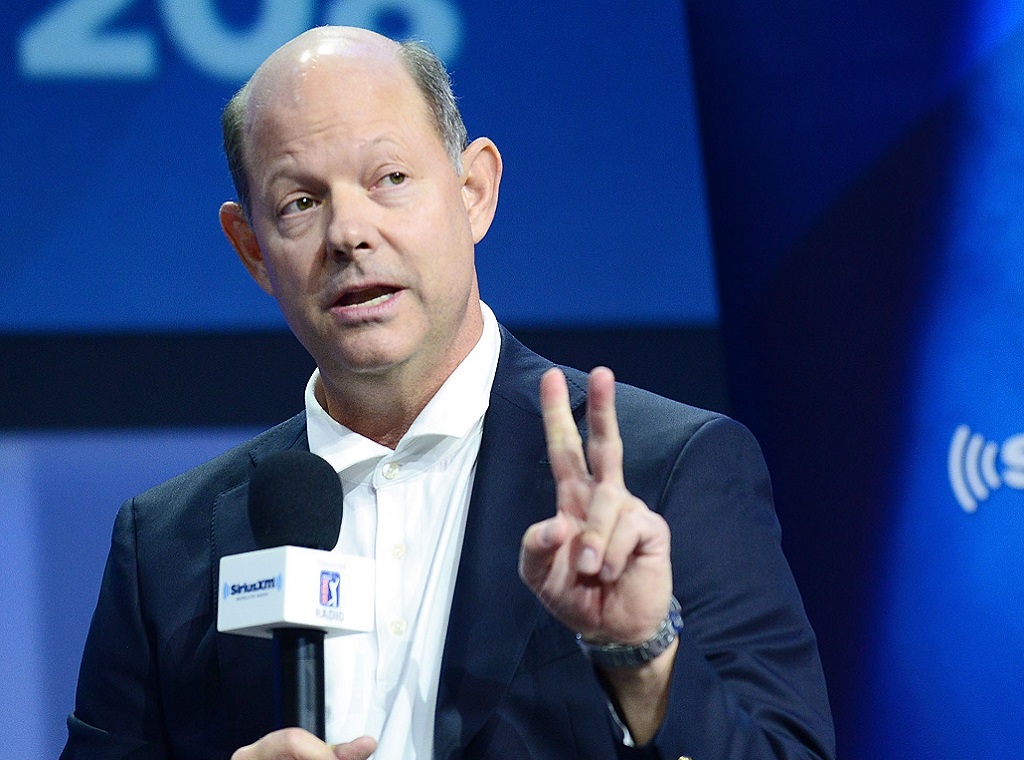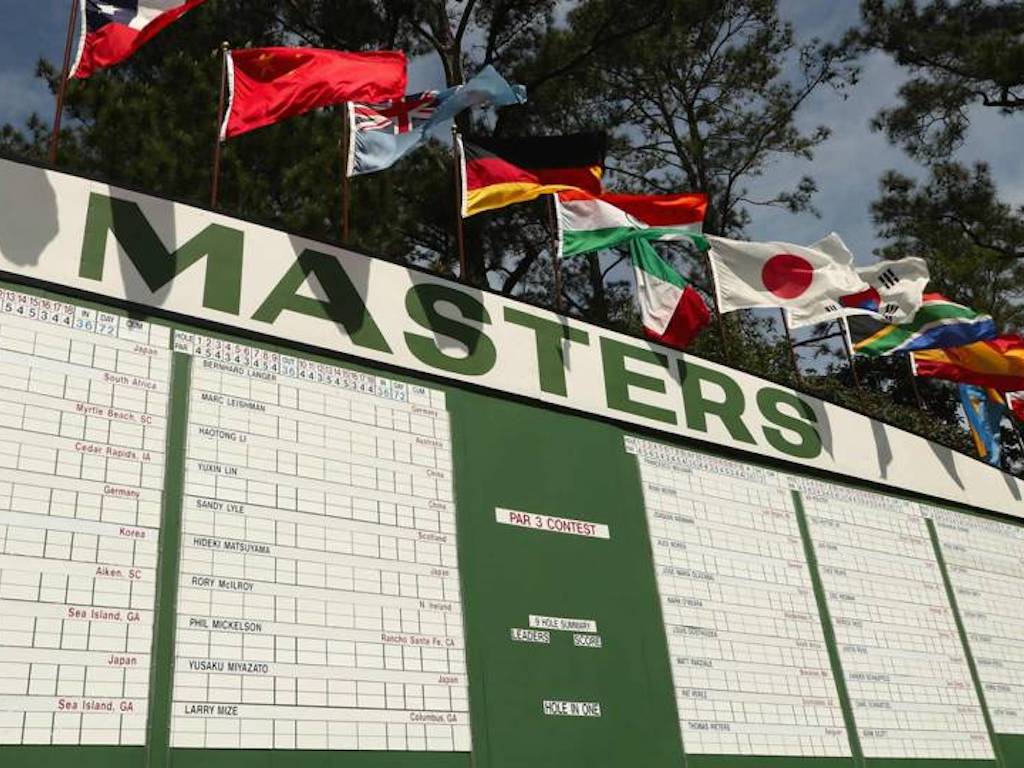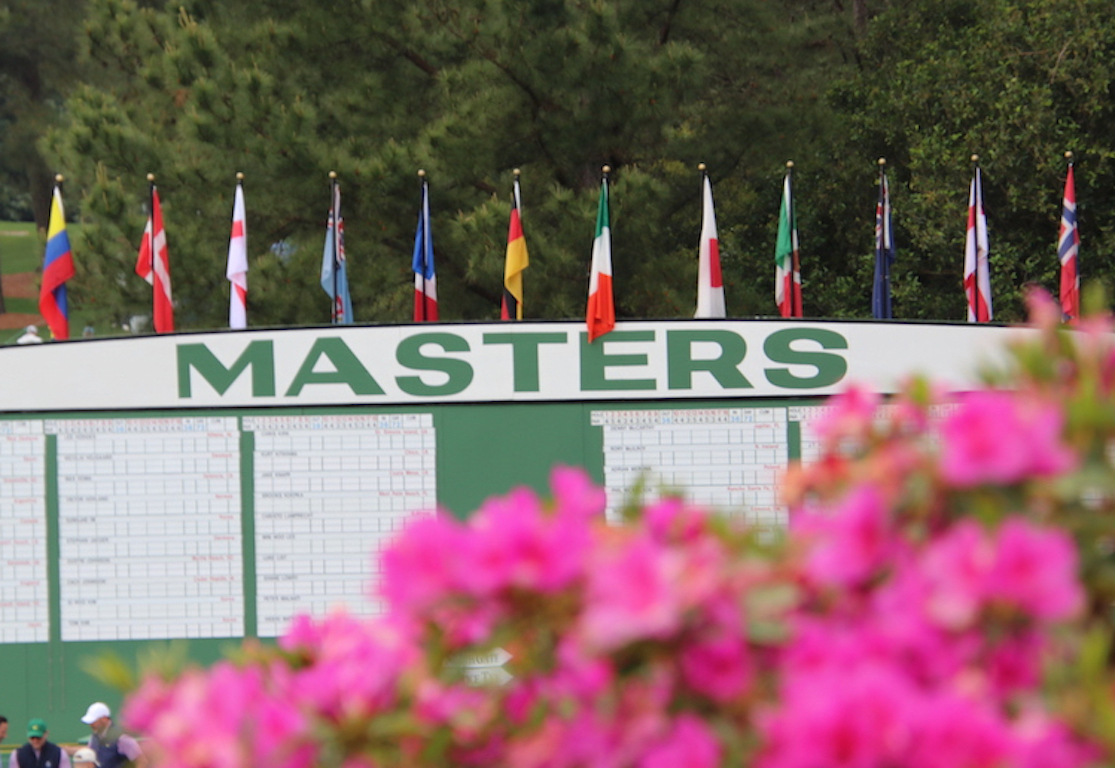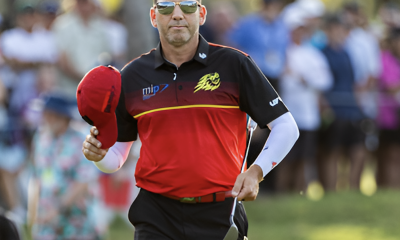News
USGA finds “unusual and concerning” distance increases in annual report

The USGA and R&A released the whispered-about report expressing concern over the largest increase in driving distance on professional tours in a decade, Monday.
The report is clear about the substantial uptick in distance off the tee in 2017
“The 2015 and 2016 editions of the distance report presented the increases in driving distance since 2003 as a slow creep of around 0.2 yards per year. The 2017 data shows a deviation from this trend. The average distance gain across the seven worldwide tours was more than 3 yards since 2016.”
It is also unequivocal about the problems posed by such gains
“Increases in distance can contribute to demands for longer, tougher and more resource-intensive golf courses at all levels of the game. These trends can impact the costs to operate golf courses and put additional pressures on golf courses in their local environmental landscape. The effect of increasing distance on the balance between skill and technology is also a key consideration. Maintaining this balance is paramount to preserving the integrity of golf.”
However, per the press release, further review/no immediate action is the order of the day, even though the statement that the organizations “remain committed to the spirit” of the so-called line in the sand (the 2002 Join Statement of Principles), which clearly stipulates action should the distance boom continue.
As Golf Digest’s Mike Stachura points out after a close read of the report, not only are we seeing all-time highs in driving distance across all tours, and a 2.5-yard increase in distance on the PGA Tour since 2016-2017, but the percentage jump from 2016-2017 to 2017-2018 thus far is more than 10 times the average annual uptick in pro golf from 2003 to 2016.
USGA chief Mike Davis and R&A head Martin Slumbers have ramped up the alarmist narrative in recent months, with Davis calling distance increases “horrible” for “all golfers.” Even so, as mentioned, the governing bodies are not currently taking any action.
“Building on the extensive research we have undertaken in recent years, we will conduct a thoughtful conversation about the effects of distance prior to making any specific proposals. We remain open-minded and our absolute priority is to ensure that all key stakeholders are involved in an open and inclusive process, and that we move forward together in the best interests of golf at all levels. There is no fixed timetable, but we will commence this process immediately and endeavor to reach a conclusion as promptly as possible.”
Here is the PDF of the full report from the governing bodies.
- LIKE57
- LEGIT5
- WOW8
- LOL10
- IDHT0
- FLOP9
- OB13
- SHANK180
News
Masters 2024: Reduced-scale clubhouse trophy and green jacket to Scottie Scheffler

In the world of golf, there is Scotty and there is Scottie. Scotty Cameron gave the world of golf a nickname for a prestigious putter line, and Scottie Scheffler has now given the golf world a blueprint for how to negotiate one of the toughest tournaments to win. Sunday, Scheffler won the Masters tournament for the second time in three years. He separated from the field around the turn, making a trio of birdies at holes eight through 10. On the long walk home, he added three more birdie at 13, 14, and 16, to secure a four-shot win over Masters and major-championship rookie Ludvig Åberg.
On No. 7, Ludvig Åberg makes birdie to move into a tie for second place. #themasters pic.twitter.com/ZSjcOr9OQK
— The Masters (@TheMasters) April 14, 2024
As the final group moved along the ninth hole, a quadrilateral stood at 7 under par, tied for the lead. Scheffler, playing partner Collin Morikawa, and penultimate pairing Max Homa and Åberg advanced equally toward Amen Corner, with the resolution of the competition well in doubt. Morikawa flinched first, getting too greedy (his words) at nine and 11. Double bogey at each dropped him farther back than he wished, and he ultimately made a 10-foot putt for bogey at the last, to tie for third position.
Ludvig Åberg made the next mistake. Whether he knew the Ben Hogan story about the approach into 11 or not, he bit off way more than he should have. His approach was never hopeful, and ended short and right in White Dogwood’s pond. Åberg finished the hole in six shots. To his credit, he played the remaining seven holes in two-under figures. Finally, Max Homa was the victim of the finicky winds over Golden Bell, the short, par-3 12th hole. His disbelief was evident, as his tee shot flew everything and landed in azaleas behind the putting surface. After two pitch shots and two putts, Homa also had a double bogey, losing shots that he could not surrender.
Why? At the ninth hole, Scottie Scheffler hit one of the finest approach shots of all time, into the final green of the first nine. Scheffler had six inches for birdie and he converted. At the 10th, he lasered another approach shot into a tricky hole location, then made another fine putt for birdie. Within the space of 30 minutes, Scheffler had seized complete control of the tournament, but Amen Corner still lurked.
Scottie Scheffler is back in sole possession of the lead. #themasters pic.twitter.com/MGytXpJcXH
— The Masters (@TheMasters) April 14, 2024
At the 11th, Scheffler played safely right with his approach. His chip shot was a wee bit too brave and left him a seven-foot comeback putt for par. He missed on the right side and gave one shot back to the course and field. His tee ball on 12 was safely aboard, and he took two putts for par. On 13, the 2022 champion drove slightly through the fairway, then reached the green, with his first two shots. His seventy-foot-plus putt for eagle eased up, four feet past the hole. His second putt went down, and he was back in the birdie zone. As on nine, his approach to 14 green finished brilliantly within six inches. His final birdie came at the 16th, where he negotiated a nine-foot putt for a deuce.
Leader by four with two to play. #themasters pic.twitter.com/KcoilYExDr
— The Masters (@TheMasters) April 14, 2024
Scheffler reached 11 under par and stood four shots clear of Ludvig Åberg when he reached the 18th tee. His drive found the lower fairway bunker on the left, and his approach settled in a vale, short and right of the green. With dexterous hands, Scheffler pitched to three feet and made the putt for par. With a big smile, he embraced caddie Ted Scott, who won for the fourth time at Augusta National, and the second with Scheffler. Ludvig Åberg finished alone in second spot, four back of the winner. Not a bad performance for the first-time major championship participant Åberg, and not a bad finish for the world No. 1 and second-time Masters champion, Scottie Scheffler.
- LIKE2
- LEGIT0
- WOW0
- LOL2
- IDHT0
- FLOP0
- OB0
- SHANK3
News
5 Things We Learned: Saturday at the Masters

Just as the honorary starters broke our hearts with the reality of ageing, so too, did Saturday, with the revelation that third-round Tiger Woods is not yet (if ever) what he once was. The great champion struggled mightily to an 82, tied with three others for high round of the day. Among the top ten, the worst score posted was DeChambeau’s 75, but the large Californian remains in the hunt. Day four will see 2022 champion Scottie Scheffler pair with Collin Morikawa in the final game. In front of them will be Max Homa and Ludwig Åberg. The antipenultimate pairing will feature DeChambeau and Xander Schauffele.
If you look at the one-off major winners, most took advantage of their only chance at grand slam glory. For golfers like Homa, Schauffele, and others, Sunday the 14th might represent their best and only chance at claiming a major title. For Scheffler, Morikawa, and DeChambeau, the ability to join the two-time and three-time, major winners club holds great appeal. Finally, a young’un like Åberg seeks to jump-start a more-than-tour-winner career with a major title. Many of the greats won them early, and the Swede from Texas Tech would love nothing more than a chance to join that company.
Sunday at Augusta, as always, will be riveting. It will provide hope throughout the first nine holes, then gut many a competitor’s heart coming home, rewarding just one with a new item for the wardrobe. Plan your menu and choose your outfit. Masters 2024 is about to conclude. Until then, let’s reveal five things that we learned on day three of the year’s first men’s major.
1. The three most critical holes on the first nine are …
numbers four through six. You might make some birdies at the first and last trios of holes, but the middle triumvirate of fairways and greens determines your day. Play them even par or better, and you’ll lose zero shots to the field. Get on a downward spiral of slightly-wayward shots, and recovery will be nigh impossible. Anyone who makes three at the fifth, as Tiger Woods did on Saturday, will get giddy.
Tiger Woods makes a lengthy birdie putt on No. 5. #themasters pic.twitter.com/bm3zw6cllK
— The Masters (@TheMasters) April 13, 2024
2. The three most important holes on the second nine are …
ten through twelve. We realize that we commit heresy by omitting one of Herbert Warren Wind’s Amen Corner traces, but par or better is critical at 10. Dry landings at 11 and 12 set the competitor up for two par fives in three holes, sandwiched around a straightforward, par-four hole. Remember when Ben Crenshaw began his march to glory in 1995? It all started with birdie at the 10th.
A three on No. 10 ties Bryson DeChambeau for second place. #themasters pic.twitter.com/EPHQARauPl
— The Masters (@TheMasters) April 13, 2024
3. The most interesting and efficient round of day three came from …
Collin Morikawa. Birdies at the first three holes, followed by bogey-birdie at six and eight, then ten consecutive pars to finish off the second-low round of the day. Morikawa has improved each day, from 71 to 70 to 69. He has won majors in England and California. He has the temperment for this sort of day, but will certainly be in the hottest of all cauldrons around 3 pm on Sunday.
Three straight birdies to open Collin Morikawa’s third round. He’s one stroke off the lead. #themasters pic.twitter.com/nzA9kSJD11
— The Masters (@TheMasters) April 13, 2024
4. The guy who lost the most ground on day three was …
Nikolai Hojgaard. The dude failed to make par from the seventh green to the 16th. After three consecutive birdies around the turn (8 through 10), the Great Dane tumbled to earth with five consecutive bogeys. 11 and 12, we understand, but 13 and 15 are par-five holes, for goodness sake! No matter where he finds himself on day four’s back nine, it will be hard to put that stretch of golf out of his mind.
Nicolai Højgaard birdies Nos. 8 and 9 to leap into a tie for second place. #themasters pic.twitter.com/Wkoh39dEKE
— The Masters (@TheMasters) April 13, 2024
5. Our pick for the green jacket is …
impossible to nail. We suspect that certain players should and could perform on Sunday. We remember when Retief Goosen, a great US Open winner until round four of 2005, lost his mojo. We recall days when Rich Beam and Y.E. Yang pulled major titles away from Tiger Woods. Things go wrong on Sunday, and they go wrong super-quick at Augusta.
We’ve decided to ascend Mount Olympus for our Sunday selection. Who better than the 2021 Olympic champion to add a long-awaited, first major title. It’s Professor X for us: Xander Schauffele.
Eagle for Scheffler. He returns to a tie for the lead. #themasters pic.twitter.com/3mWXrXVTL6
— The Masters (@TheMasters) April 13, 2024
- LIKE5
- LEGIT0
- WOW0
- LOL3
- IDHT0
- FLOP1
- OB0
- SHANK5
News
5 Things We Learned: Friday at the Masters

You don’t see leaves on the ground at Augusta National. The grounds crew and superintendent’s staff take care of those sorts of things, so that both course appearance and consistency of play are preserved at the top tier. We saw leaves on the ground today and, given the force and perseverance of the wind, we’re lucky that we didn’t see tree trunks along the fairways. We did see higher scores than secured in round one, and some of the three- and four-hole stretches were downright inconceivable. The cut after 36 holes came at six over par, and five dozen golfers reached the weekend of play. Numbers always define the story of a tournament, and we’ll let them define the five things we learned on day two of the 2024 Masters tournament.
One: 60 + 10
Sixty golfers posted scores of 148 or better through 36 holes, to reach weekend play. Ten more golfers posted 149 and missed the cut by a single stroke. The ones who missed the cut by a stroke included former champions Mike Weir, Zach Johnson, and Sergio Garcia. Also among the brood were current US Open champion Wyndham Clark, and Nick Dunlap, who won on the PGA Tour as an amateur in January, and subsequently turned professional. Of the ones who survived by the slimmest of margins, surviving to the weekend were former champions Jose Maria Olazabal, Hideki Matsuyama, and Adam Scott, along with Rickie Fowler and Tom Kim. Golf’s cut is a cruel and unconcerned blade, and each Masters tournament reminds us of this fact.
Tom Kim makes just the third birdie of the day on hole No. 4. #themasters pic.twitter.com/gtlLbVcQi6
— The Masters (@TheMasters) April 11, 2024
Two: One
The number of amateurs to make the cut in the 2024 Masters is solitary. His name is Neil Shipley, and most folks love him. He wears his hair to the shoulder, and appears to have the proper balance of intensity and chill. Shipley opened with 71, then held on for 76 on day two. He made the cut by three shots, and will collect his share of hardware on Sunday. It’s safe to say that Shipley will turn his attention to learning the course, as well as his own self under pressure.
Following a birdie on No. 13, Neal Shipley is the lowest amateur on the course. #themasters pic.twitter.com/3MAjI3yltE
— The Masters (@TheMasters) April 11, 2024
Three: 23
For most sorts fans, 23 recalls the greatest NBA player of all time, Michael Jordan. For Justin Thomas, it’s a number that will haunt him for a long time. Thomas reached tee number fifteen on Friday at even par. The two-time PGA Champion played the subsequent, four-hole stretch in 23 shots, missing the cut by a shot. On fifteen, he went for the green in two, in some sort of halfhearted manner. He got wet with shot number two, went long with his pitch, and three-putted from the fringe. On sixteen, he played away from safety and found elevated sand. His blast went down the hill, and he missed his approach putt in the wrong place. On seventeen, he missed his drive right and his approach long, and lost another shot to par. The coup de grace took place on the home hole: drive so horribly left that he had to pitch out to the fairway and hit three metal into the green. His third double bogey in four holes dropped him all the way to 151 and plus seven. Among the many questions, the foremost one was why he dropped his longtime caddy on the eve of a major championship. Surely Bones would have saved him one of those shots, and perhaps more.
Justin Thomas | 15th Hole, Round 2, Stroke 2 https://t.co/TYudRsbM8g
— ?????BuffaloGolfer.Com????? (@buffalogolfer) April 13, 2024
Four: Forty-Nine divided by five or six
Tiger Woods cannot possibly win title number six at Augusta in his 49th year, can he? Not on this broken body, and not from seven strokes behind, right? Not with so few competitive rounds over the most recent months, and not one year removed from a third-round withdrawal from this very tournament. Well, if he cannnot possibly win, allow us to dream and hope a bit, and hold on to a fantasy.
Tiger Woods gets back to one over par with chip-in birdie on No. 6. #themasters pic.twitter.com/h4G5CrbgdJ
— The Masters (@TheMasters) April 12, 2024
Five: 3 that we like
We like Scottie Scheffler, of course. He seems to have a sense of Augusta National, and he was able to hold on in 2023 for the championship. We like Nikolai Hojgaard, because he might have just the proper combination of naivete and experience for a first-time winner. Finally, we like Collin Morikawa, a winner of two separate major titles. Winning at Augusta National requires a certain amount of length, unless you putt lights out. Morikawa might be embedded in one of those putting weeks.
Nicolai Højgaard chips in on No. 7 to move to red numbers. #themasters pic.twitter.com/CTE34kuOdh
— The Masters (@TheMasters) April 11, 2024
- LIKE0
- LEGIT0
- WOW0
- LOL1
- IDHT0
- FLOP0
- OB0
- SHANK0
-

 19th Hole6 days ago
19th Hole6 days agoDave Portnoy places monstrous outright bet for the 2024 Masters
-

 19th Hole2 weeks ago
19th Hole2 weeks agoThings got heated at the Houston Open between Tony Finau and Alejandro Tosti. Here’s why
-

 19th Hole7 days ago
19th Hole7 days agoTiger Woods arrives at 2024 Masters equipped with a putter that may surprise you
-

 19th Hole2 weeks ago
19th Hole2 weeks agoReport: Tiger Woods has ‘eliminated sex’ in preparation for the 2024 Masters
-

 19th Hole1 day ago
19th Hole1 day agoTwo star names reportedly blanked Jon Rahm all week at the Masters
-

 19th Hole2 weeks ago
19th Hole2 weeks agoAddiction, spinal fusion, and scam artists – Everything Anthony Kim revealed in candid interview with David Feherty
-

 19th Hole2 weeks ago
19th Hole2 weeks agoAnthony Kim says doctors told him that he ‘may not have much time left’ ahead of LIV return
-

 19th Hole1 week ago
19th Hole1 week agoBrooks Koepka and Sergio Garcia make significant equipment changes as 2024 Masters looms


















GMatt
Mar 7, 2018 at 12:05 pm
Again, the USGA is out of touch with 99.99% of the golfers in the world. Why are they concerned with distance of maybe 1,000 touring pros in the world when the distance of millions of normal amateur golfers hasn’t really changed, same as handicaps….
For an organization that is supposedly around to grow the game, they sure are doing their best to stagnate it a best. What is increasing distance? (not necessarily in order of importance) agronomy-better turf conditions than in years past, better equipment, lower spinning ball, bigger and more athletic players. So I guess in addition to rolling back the ball, the USGA should limit strength and size of us players, they should roll back the care of the course to goat pastures of years past, they should take over the equipment companies and tell them to no longer innovate and improve golf clubs and balls.
Does this all sound absurdly stupid to you? Perhaps the USGA should listen to the very people they claim to represent and not cater to their own agenda. Both Matt Adams and Michael Breed this morning were extremely outspoken about this very subject
JThunder
Mar 6, 2018 at 11:25 pm
Instead of rolling back the ball, how about a limit on height and fitness of tour players?
If you want to protect par, just reduce the par by one on every PGA Tour hole.
JThunder
Mar 6, 2018 at 11:23 pm
If they want real numbers, maybe they should be measuring more than two holes per tournament. Seems like a lot can go wrong with that baseline, as I believe the PGA Tour and others are now pointing out.
Have they genuinely kept track of “driver use” on these holes over the years. Today’s top players seem to hit 3 wood less and less – Dustin, Justin, etc. It doesn’t take much to change a stat by 3 yards (at 300 yd drive ~ 1% gain) if a few pros go from 3wd to driver.
MT
Mar 6, 2018 at 4:32 am
Don’t know about you guys, but I hate one sided half the story reporting.
They state the 3 yards as some huge “Oh No”.
What they don’t mention is the average swing speed of tour players over the last 10 years.
To prove their point. They need to show swing speed staying the same while distance is increasing.
The data is all there and available. Swing speed vs ball speed vs distance.
Matt
Mar 6, 2018 at 10:29 am
Roll it back!!
This isn’t about hackers. If you carry it 220 or less off the tee, which something like 90% of golfers do, you won’t even notice a difference. You don’t compress the ball enough for it to matter. These changes will stop the 200 yard 7 irons and 330 yard drives. Bring back some shaping and skill. Shorten courses, so you can walk them, and play in less than 6 hours. The longer the ball goes the further off line it goes. Less time in the woods, less time waiting behind foursomes looking for balls. Etc. etc. etc.
Roll it back!
Matt
Mar 6, 2018 at 10:30 am
Didn’t mean to reply to your comment – just a general comment.
Steve
Mar 5, 2018 at 7:26 pm
I just took up golf this past summer. I am not very good, but I have learned that eventually I will know the distance for each club. I would think the pros should be much more efficient at that than I am, so who cares what the length of the course is.
Du
Mar 6, 2018 at 3:25 am
No need to lie, dude
DaveT
Mar 5, 2018 at 5:42 pm
My position is that the USGA is not interested in protecting golf; they are interested in protecting par. They’d do a lot more for golf if they ignored the 3yd/drive/year increase, and allow the Tour to amaze us viewers even more than they do now. That will sustain interest in the game on TV. I guarantee nobody I play golf with is going to threaten the viability of today’s golf courses. If you make the courses play longer (either by changing the courses, the ball, or the clubs), you’ll anger the vast majority of golfers.
Anthony
Mar 5, 2018 at 3:43 pm
3 yards? Better make the golf courses 8000 yards to combat that!
What a load of the proverbial!!!!
John
Mar 5, 2018 at 3:29 pm
For years the PGA and R&A have tried to tackle the distance issue by lengthening courses. Any fool can see that this merely plays into the hands of the bigger hitters. If I had anything to do with it I’d shorten the courses and bring the shorter guys into the picture. Make the course layouts reward skill rather than brute force. The old ‘drive for show, putt for sigh’ maxim still holds true but to a far lesser extent nowadays. Shorter courses might also address the nonsense of six hour rounds. Not by much probably but any reduction would be welcome.
John
Mar 5, 2018 at 3:32 pm
‘Drive for show, putt for dough’ obviously. Damn autocorrect!
Alfredo Smith
Mar 5, 2018 at 2:42 pm
SHANK! The only thing that needs rolling is a big fat doobie after reading this nonsense.
Patricknorm
Mar 5, 2018 at 2:33 pm
I’ve been to many PGA Tour events, and the one that I notice right away is how big most players are. 30 years ago the odd player was over 6’1” but today when you see a Tony Finau or Dustin Johnson even Matt Kuchar, they’re all over 6’3”. 30 years ago before Tiger came along and purses increased, those athletes may have tried other sports like tennis or basketball. Plus, you can’t dismiss the John Daly effect who gave kids permission to “ grip and rip” the ball. Today most players , when they drive the ball, are out of their shoes.
And then add in technology and better agronomy, well it was bound to happen.
joe
Mar 5, 2018 at 1:13 pm
Make the pro’s go back to persimmon, we’ll see who the best golfers really are…
Mikele
Mar 5, 2018 at 2:24 pm
Let’s go back to Radio Shack 64k RAM computers so we can see who the real computer users are.
Dumb, dumb, dumb.
Dr Troy
Mar 5, 2018 at 4:18 pm
Exactly….3 yards is nothing. Everyone needs to go chill out and move on to other world problems in Golf.
george
Mar 5, 2018 at 1:09 pm
No need to roll back the ball for us amateurs. Just outlaw the Trackman/Flightscope/GCQuad.
JD
Mar 5, 2018 at 12:43 pm
Yeah I’m sure the cost of extending a par 4 at Augusta is going to trickle down to the muni courses I play.
Rich
Mar 5, 2018 at 12:40 pm
WOW! Are you kidding me? The players are in better condition,use better methods in training,video usage and the equipment has better materials and technology designs while meeting the rules.. It isn’t the ball it’s the layout of courses .The course should be designed or altered to make it a PLAYER’s course ,MORE RUFF,SAND,TREES,WATER,SHRUBS GREENS that have more shape and contour deeper sand traps. The Tour had decided wrongly that people wanted to see lower scores when in we really want tougher courses .That’s why the British open ,US open are the best matches and watched by more people than the regular tour matches. IT’s ABOUT SHOT SHAPING, DECISION MAKING AND RISK TAKING !!!
Brian
Mar 5, 2018 at 12:25 pm
Maybe fairways shouldn’t be designed to allow a hundred yards of roll out?! Rather than dial back the golf ball, dial back the course set up a little. But this is what the USGA wanted, along with everyone else: to see the likes of DJ ripping the ball further than anyone has ever done before on national tv. Now that everyone is doing it, it’s not cool anymore and by golly we need to fix this “equipment problem”! No one stops to think for a second that with the heyday of the TW era, the youth who grew up watching him physically dominate courses are now in the tour and working out, getting stronger, and more physically dominate than ever before as a whole coupled with course set ups to allow it. But keep telling yourselves it’s the equipment and golf ball’s fault…
C
Mar 5, 2018 at 12:50 pm
My thoughts exactly. Rollout.
Mike Cuttone
Mar 6, 2018 at 12:57 pm
THIS^^^^^^^^^^^^^^^^^WELL SAID
juliette
Mar 5, 2018 at 12:09 pm
I get it about distance. As someone more or less in the lowest percentile of distance compared to the mostly men who comment on golf wrx I should be the most opposed to changes limiting my distance. But I see Mike Davis’ point about resource utilization in an era where most of us agree that something is going on here with this Earth and this extreme weather. Needing more land for golf courses, more water, more fertilizer more more more more more is not the time to start being blind to this and caring only about how far your 6 iron goes.
Murv
Mar 5, 2018 at 12:22 pm
Yeah, we need to reduce golf ball distance to save the world from global warming.
Bub
Mar 5, 2018 at 1:24 pm
Good plan, that way anyone that doesn’t want to ‘roll back’ the golf ball can be accused of hating the planet and children.
Mikele
Mar 5, 2018 at 2:29 pm
Juliette – You aere wasting your time with that argument on this website. Your sincere concern will be deemed political by the cretin crowd here. You don’t really think they bothered to read the report, do you? That would put it into context and god forbid they should go beyond the headline or blurb.
youraway
Mar 5, 2018 at 5:56 pm
Perfect – absolutely perfect response.
Wyomick
Mar 6, 2018 at 7:39 am
Anybody want to bring up Hitler? I’m sure the long ball hitters that want to destroy the planet are related or st least guilty of his nefarious intentions. Good grief. Go away, far away from golf please.
dvers
Mar 6, 2018 at 10:57 am
Is this GolfWRX or CPAC? For a group that alludes to the “snowflakes” of the opposing ideology, commentators on many of these articles get irrationally defensive about a political claim that often doesn’t even exist. Golf isn’t exclusively for men with Rs after their names. Lighten up and/or take it to the Breitbart forums please.